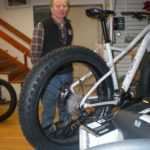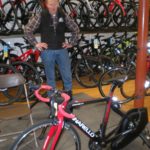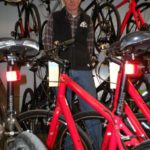Bicycles and Bicycling in Belmont
Interview and photos by Sumner Brown
Peter Mooney is one of three owners of Wheel-works, the bicycle store in Waverley Square. He is also the store manager and a frame builder. Peter bikes to work and was a racer in his youth. We started our interview by walking out of the meticulously clean showroom, past hundreds of shiny new bicycles, clothing, parts, and accessories, back to where Peter has his shop. Once we got to the shop, Peter started talking.

Peter Mooney in his shop at Wheelworks
Peter: I have never met a bicycle I do not like. To me, it doesn’t matter what sort of bike you ride. Put in your hours riding a bike, any bike, and you are a member of the bicycle riding brotherhood/sisterhood.
The original bicycle boom was between 1880 and 1900. During that time the penny farthings—bicycles with a huge front wheel with pedals directly attached—were replaced with what were called safety bicycles, essentially the format of almost all bicycles now, with the rider sitting between two wheels, and pedals connected to a wheel with a chain. Safety bicycles really were much safer and easier to ride. More and more people started riding. Women started riding. That boom ended with the advent of the automobile.
The urban riding environment can be very intimidating on a bike. The new network of bike lanes with the signage and traffic pattern changes they entail are a great reminder to drivers that they need to expect bikes and share the road. These paths are a great confidence builder for cyclists. That said, don’t get overly confident, especially where paths change, transition, or disappear altogether. If your commute distance is too great, or arriving sweaty to work is the problem, consider an electric-assist bike.
Winter commuting is hard on a bicycle. Salt and sand take a toll. A winter program of cleaning and maintenance is important.
During warm weather, we continue to have a bicycle boom here at Wheelworks. In the thick of winter, we joke that we cannot give bicycles away.
Sumner: It seems that more people should enjoy bicycling. What’s wrong?
Peter: Personally I find that riding a bicycle is much more enjoyable when I am in shape. Some people spend hours on the internet participating in bicycle forums. I tell them if your screen time became riding time you will achieve super fitness in no time. Getting out the door can be the hardest part of your bike ride. Fifteen minutes into your ride, you will wonder why the hesitation!
The first ingredient for enjoying bicycling is getting into shape. The second is finding bicycle-friendly roads. Choose the right time of day. Avoid rush hours and get onto New England’s unbeatable network of back roads. Avoid the roads with numbers. Enjoy roads with varying terrain and overhead trees. Pick riding buddies who are compatible.
Sumner: How can a person find group rides?
Peter: The Wheelworks website has a calendar of events and rides. It is important to pick a group ride that is suited to your speed and temperament. Cycling can be a very social event. Ride leaders need to enforce a group etiquette and not allow slower riders to disappear off the back.
Sumner: How can people learn to repair bicycles?
Peter: We have classes here. We offer six-hour classes that are popular. They are split into two three-hour sessions. They are taught by Ed Munafo, a former junior high school teacher. He is great. We also have other repair class formats. See the “Park Tool School” listing in the Repair section of our website.
Sumner: Did you learn bicycle mechanics by taking classes?
Peter: No. When we were young, basic mechanical training was taught at school. If you had a mechanical aptitude, you learned at home by taking things apart. That is still a great way to learn. Watch for a discarded bike on trash day and take it apart. I had a youngster and a distraught mother come in with what had been a new bicycle a short time ago, but now was in pieces. I had to explain to the kid that what he did shows commendable curiosity, but next time practice on something that didn’t cost your mother so much money.
A lot of bicycles end up in the trash. To successfully revive a trashed bicycle requires that you know the difference between junk and a bicycle with potential. Restoring junk bikes can get expensive and can be dangerous if not done correctly.
- Carbon fiber frames
- The fat rear wheel of a “fat” bicycle
- A bicycle on a high-end trainer
- Hybrid bicycles
Sumner: Show me some bikes in the showroom.
Peter: For most people, a hybrid bicycle is a good start. Hybrid bicycles have straight, upright, comfortable handlebars and wide-range gearing for hills. We have some with airless, no-flats tires, like LimeBikes.
Bikes best suited for commuting will usually have wider tires, carrier racks, fenders, and lights. Disk brakes, internal gear rear hubs, and a “belt” drive (to replace the traditional chain) are all nice upgrades to a commuting bike.
Disk brakes are increasingly common on all types of bicycles. They require much less brake lever force and they do not wear away the sides of the wheel rims, increasing rim life.

A high-end commuting bike with a belt instead of a chain, a rear hub with many gears inside, and disk brakes
Some high-end performance bicycles have electronically controlled derailleurs. These get software updates. Some bicycles have GPS navigational aid holders factory-installed. Personally, I still use paper maps.
We have single-speed bicycles, often called fixies. Fixies are popular as urban commuting bikes. Their simplicity makes maintenance easy. Fixies differ from single-speed freewheel bikes as a “fixed” wheel will not allow you to coast or “freewheel.” You are always pedaling, uphill and downhill.
Sumner: If you are young and strong, you can get up hills without changing gears.
Peter: Electric-assisted bicycles are a growing part of our business. These are not motorcycles. They have no throttle. The electric motor assists you. The harder you pedal, the more assist you get. Set the system for less assist, and your battery lasts longer before recharging. The electric bicycles we now have are solid and serviceable.
Here is a cargo bicycle with electric assist. Jeff Roth (chairman of the first Belmont Community Path Committee) and his family have an e-assisted cargo bike. They can put their kids on the back with a load of groceries and get up the hill to home.

Peter Mooney with an electric-assist cargo bike at Wheelworks
Fat bicycles have large cross-section tires that are inflated to low pressure. They can ride over things offroad. They can do well on snow and sand. They are used for mountain biking as an alternative to full suspensions frames to absorb the bumps of rough terrain.
Cyclocross is something to consider if you want to race while avoiding roads and traffic. It is cross country racing on closed courses that usually have some sections where riders pick up their bicycles and run. Cyclocross bicycles are basically road bikes with higher cranks for more ground clearance.
For keen athletes who need to keep in shape during the winter in New England, there are smart trainers. You put your bike on a trainer inside and pedal. The best modern trainers completely replace the back wheel and are calibrated and connected online so users all over the world can simultaneously race against each other. We also have simpler options for regular folks who want to get some indoor bicycle exercise.
Sumner: I see carbon fiber frames, steel frames, aluminum frames, and titanium. I have always been happy with steel. Am I missing something?
Peter: All of those materials can make excellent bicycle frames. Currently the industry darling is carbon fiber. Look at these. You can spot the carbon fiber bicycles easily because they have appealing, aerodynamic design that’s sculpted for visual attraction. Carbon fiber is the frame choice for high-end road bicycles. Mountain bicycles are also made from carbon fiber. Metal frames are not sculpted in that way. Steel was the dominant material 30-plus years ago. Back then the tubes of the frame were joined by lugs and brazing. Now most steel frames are welded without lugs. Steel is out of fashion. Aluminum is the favored metal for high volume production now. Titanium has the advantage that it does not rust. It can be left bare and has a natural sheen that is attractive and lasts.
Sumner: How are bike paths going to affect bicycling?
Peter: Bike paths are wonderful. Some people will ride only on a bike path. They load their bike on a car and drive to a path. As bike paths get built and as they become increasingly interconnected, more people will be able to get somewhere on paths, so they will be useful for transportation. The paths that follow the Central Massachusetts Railroad route will pass three houses away from where I live and come to Waverley Square here. That will be great for me. I hope to live long enough to get to use it.

A Peter Mooney steel frame bicycle
Sumner: I think of bike paths as training wheels for adults. New riders will gain confidence in their bicycle skills on a path so they will dare to bicycle on roads for transportation. Will that work?
Peter: Bikes, like pianos, need practice. The more you use one, the more comfortable and confident you become. As a new bike rider, any riding experience that creates confidence is huge.
_______________
If you want advice about what bike to buy, tell Wheelworks about yourself. They will make suggestions. The least expensive new bike is a bit over $400. The most expensive bikes are over $10,000. The tuition for a six-hour maintenance class is $100. Being healthy and in shape is priceless.
Sumner Brown is a director of the Belmont Citizens Forum.






Sorry, the comment form is closed at this time.